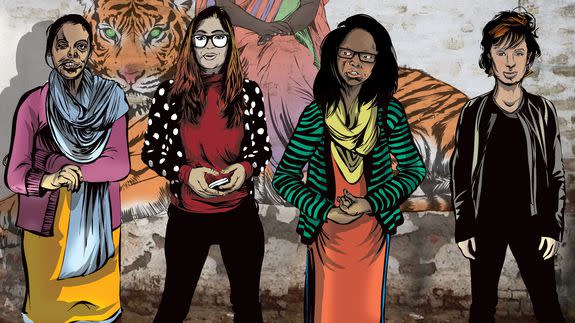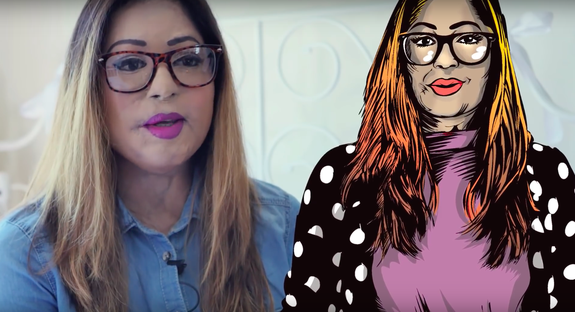New augmented reality comic book shows the resilience of acid attack survivors

As an acid attack survivor, Monica Singh once found it incredibly difficult to look in the mirror. Her scarred skin brought her back to the day men poured a bucket of acid on her in Lucknow, India — a violent retaliation for her rejection of a marriage proposal.
More than half of Singh's body was burned instantly, altering her appearance forever. But the activist says using a mirror has helped her reclaim love for her reflection, and for herself.
SEE ALSO: 8 instances of everyday Indian women who have broken barriers
More than a decade after her attack, Singh's story is now being used to empower other acid attack survivors through an unusual medium — a comic book. Titled Priya's Mirror, the book uses augmented reality and image recognition to bring its characters to life on any mobile device.
Singh was the inspiration for Anjali, one of the book's main characters. The narrative itself, which is based on the format of Hindu mythological tales, curates the real-life stories of several acid attack survivors in India.

Image: Priya's Mirror
"I became my own strength," Singh tells Mashable. "I used the mirror as a type of therapy to accept what happened to me — and that story was very much intertwined into the comic book. The mirror is Priya's Mirror, but it's also Monica's Mirror, too."
Priya's Mirror was created by producer Ram Devineni and artist Dan Goldman to help address the stigma and shame around this type of gendered violence. In the book, Priya is a gang-rape survivor who helps inspire a group of acid attack survivors to escape the rule of the demon king, Ahankar — or "Ego" in Hindi.
It was co-produced by Singh's foundation, the Mahendra Singh Foundation, as well as Fundacion Natalia Ponce de Leon — both nonprofits supporting victims of physical abuse, sexual abuse and acid attacks. Priya's Mirror is also the first comic book ever funded by the World Bank.
The creators hope the comic will ultimately help foster solidarity among survivors of gender-based violence.
Priya's Mirror is the second chapter in the Priya series, following the hugely successful Priya's Shakti, which introduced the story of the titular character. The first chapter was created in response to the gang rape of a woman on a bus in Delhi in 2012, covered widely by media outlets around the world.
Priya's Shakti was the first of its kind, using augmented reality technology to enhance the overall experience for readers. It has had more than 500,000 downloads since its release in December 2014, and will even be implemented in school curricula in Delhi next spring. Devineni wants Priya's Mirror to continue that success, broadening awareness and action against gendered violence.
Though acid attacks have been reported globally, they are extremely prevalent in South Asia. India, specifically, has some of the highest rates of acid attacks in the world, though reliable statistics are difficult to obtain, due to stigma and underreporting by authorities. According to Acid Survivors Foundation India, there were at least 249 acid instances of acid attacks in India in 2015, up from 225 incidents in 2014.
Devineni says the inspiration for Priya's Mirror came when he met with acid attack survivors in New Delhi in December 2015. He listened to their personal experiences of violence and stigma, and quickly learned that their stories directly mirrored those he heard from rape survivors while researching for Priya's Shakti.
"You could literally transpose one interview over another, and you couldn't tell the difference," Devineni tells Mashable. "[Acid attack survivors] went through the same cultural problems that rape survivors went through — with the exception that they were not only internally traumatized, but physically traumatized as well."
He then began planning Priya's Mirror, in which these shared experiences come together.

Image: Priya's Mirror
But Devineni acknowledges that telling these deeply traumatic and personal stories of violent attacks can get tricky. In creating the narrative for Priya's Mirror, he says it was crucial for survivors to vet their own representations.
"We make sure when we write the comic book that it is reviewed by the survivors," he says. "They are part of the review process, making sure they are represented with respect and dignity."
There was also the challenge of sensitively illustrating each survivor's physical appearance. In Priya's Mirror, Devineni and Goldman illustrated real-life acid attack survivors, turning them into superheroes as an integral part of the story. The survivors worked closely with Goldman on what their illustrated versions would look like.
Devineni says the artwork went through several rounds of editorial changes, ensuring the survivors were represented responsibly.
"That was especially a challenge of this second chapter — trying to draw the women with dignity and respect," he says. "It could easily go into some horrific look, and we didn't want that. We wanted to make sure they, as women and as human beings, were represented with honor."

Image: Priya's Mirror/Rattapallax/Youtube
While readers can experience Priya's Mirror as a standard comic book, the augmented reality component allows them to interact with it further. Powered through the free visual discovery app Blippar, users can hold their phones or tablets up to the comic's pages to unlock videos and animated content.
Through Blippar, Devineni says viewers can see acid attack survivors tell their own stories, similar to the tech used for Priya's Shakti (shown in the video below).
Users can also participate in an awareness campaign inspired by activist and acid attack survivor Natalia Ponce de León. In 2014, a man Ponce de León had never spoken to poured a liter of sulfuric acid on her in Bogota, Colombia. Her story was highly publicized in the country, encouraging her to fight for policy changes that would help prevent acid attacks.
Her campaign, called The Last Mask, gained mass attention in 2014, when Ponce de León sent out clear masks mimicking acid burns to media and celebrities around the country. She encouraged them to take photos and share them on social media in an effort to change Colombian law — specifically legislation that would make it harder to get acid over the counter, and increase penalties against aggressors. And it worked.
Through Blippar, readers of Priya's Mirror can continue a version of the campaign by virtually wearing a digital mask and posting it to social media to show their support.
"We literally took that same campaign and same mask and put it into the virtual reality," Devineni says. "You can scan the cover of the comic book and you will be able to take the mask and put it on your face — almost like Snapchat."

Image: Blippar/Priya's Mirror
Though the comic book and augmented reality features aim to empower survivors, Devineni says teenage boys are the true audience they're targeting. Young boys are the next generation of potential aggressors, and they're essential in the fight to shift a culture that normalizes all forms gendered violence.
"That's one of the main reasons we choose comic books, as opposed to a fictional or a nonfiction book," Devineni says. "But also having that additional tech component of AR is much more eye-candy incentive for teenagers to pick it up."
The tactic is definitely making a change, according to Devineni, who points to the success of Priya's Shakti as proof.
"Now, you see in India people talking about how society treats rape survivors," Devineni says. "I'm not saying a comic book is the reason this has changed, but we were definitely a part of this. The creation of a rape survivor who was also a superhero really helped to create an alternative narrative."
With the release of Priya's Mirror, survivors involved in the project are already seeing the value in the medium.
Singh calls the comic book a form of "cultural education," hoping it will reduce instances of acid attacks around the world, and help alleviate the stigma and shame that survivors face. But while encouraging society to support acid attack survivors is essential, Singh says it's even more critical for survivors to celebrate their own resilience.

Image: Priya's Mirror
"You can do anything now," she says to survivors like her. "The worst thing that could happen to a girl has already been done to us. I wish nobody would go through the same thing. But, for us, it has allowed us to become fearless."
Priya's Mirror, along with an accompanying exhibition, premiered at Lincoln Center on Sept. 30 as part of the New York Film Festival. The comic book will officially launch in India at Mumbai Comic Con on Oct. 22 and 23, and is currently available for free download in English, Spanish, Italian, Portuguese and Hindi.

 Yahoo News
Yahoo News 